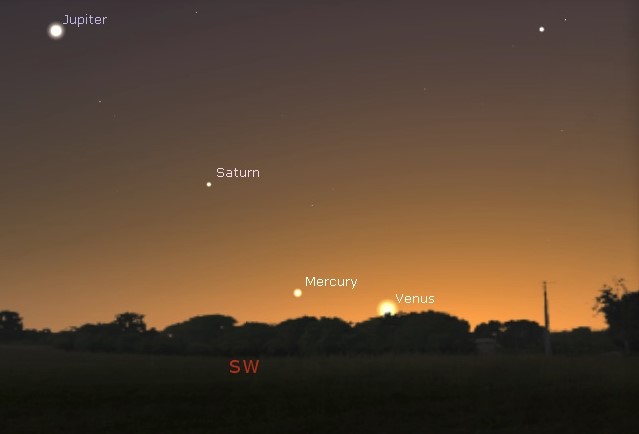This Week’s Sky at a Glance, 2022 January 1 – 8 ~by Curt Nason
Around midnight in the first week of January the brightest star in the night sky is due south, at its highest above the horizon. Astronomers would say it is transiting the meridian when it crosses the north-south line. Many 19th century observatories, including the one now called the William Brydone Jack Observatory at UNB Fredericton, would collaborate in timing the transits of stars to determine the longitudes of their observatories.
Sirius is called the Dog Star because is part of the constellation Canis Major the Great Dog, one of Orion’s hunting companions. If you are unsure which star is Sirius, follow Orion’s Belt down to the left. The star is about twice the size of the Sun and 25 times more luminous, but that is not why it is the brightest. It is only 8.6 light years away, a mere 82 trillion kilometres, and the nearest naked eye star for us in New Brunswick. The name means “scorcher” or “scintillating one” and it often twinkles wildly and colourfully, especially when it is lower in the sky. I like to observe it with binoculars or a telescope just to enjoy the light show. Look for the star cluster M41 about a binocular field below Sirius. With the Sun passing above Orion in summer, people once believed the hot days were due to extra heat from Sirius, hence the term “dog days of summer.”
This Week in the Solar System
Saturday’s sunrise in Moncton is at 8:01 am and sunset will occur at 4:44 pm, giving 8 hours, 43 minutes of daylight (8:03 am and 4:52 pm in Saint John). Next Saturday the Sun will rise at 8:00 am and set at 4:51 pm, giving 8 hours, 51 minutes of daylight (8:02 am and 4:59 pm in Saint John). The latest sunrise for the year occurs this weekend.
The new Moon on Sunday occurs less than a day after perigee so we can expect extreme tides early in the week. From Monday through Wednesday the waxing crescent passes to the left of Mercury and Venus, Saturn and then Jupiter. Mercury makes a beeline from upper left of Venus toward Saturn over the week and should be visible to the naked eye as it is brighter than Saturn, but try first with binoculars. Jupiter offers a treat for telescope users early Wednesday evening, with Ganymede ending a transit at 7 pm, its shadow beginning a transit at 7:22, and moon Io disappearing behind the planet at 7:34. This weekend Mars slides down to the left of its currently brighter namesake, the orange supergiant star Antares – “the rival of Mars.”
Questions? Contact Curt Nason.

